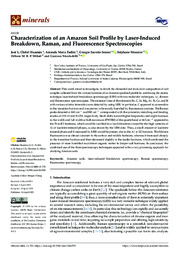Characterization of an Amazon Soil Profile by Laser-Induced Breakdown, Raman, and Fluorescence Spectroscopies.
Characterization of an Amazon Soil Profile by Laser-Induced Breakdown, Raman, and Fluorescence Spectroscopies.
Author(s): HUAMÁN, J. L. C.; TADINI, A. M.; SENESI, G. S.; MOUNIER, S.; MILORI, D. M. B. P.; NICOLODELLI, G.
Summary: This work aimed to investigate, in detail, the elemental and molecular composition of soil samples collected from the various horizons of an Amazon spodosol profile by combining the atomic technique laser-induced breakdown spectroscopy (LIBS) with two molecular techniques, i.e., Raman and fluorescence spectroscopies. The emission lines of the elements Fe, C, Si, Mg, Al, Ti, Ca, and K with various relative intensities were detected by using LIBS. In particular, C appeared to accumulate in the transition horizon and was proven to be mostly humified by fluorescence analysis. The Raman peaks detected at 465 cm?1 and 800 cm?1 corresponded with the symmetric stretching and bending modes of O-Si-O and Si-OH, respectively. Small shifts toward higher frequencies and slight increases in the width and full width at half maximum (FWHM) of the quartz band at 465 cm?1 appeared in the Tr to K2 horizons, which could be ascribed to a local distortion caused by the high contents of Al of kaolinite mineral phases, as also shown by the LIBS data. Thus, a small amount of kaolinite mineral phase and K measured by LIBS would be present also in the A1 to E2 horizons. The lifetime fluorescence was almost constant in the surface and middle horizons, whereas it increased sharply in the transition horizon and then decreased slightly in the kaolin horizons, which confirmed the presence of more humified recalcitrant organic matter in deeper soil horizons. In conclusion, thecombined use of the three spectroscopic techniques appeared to be a very promising approach forstudying Amazon soils.
Publication year: 2023
Types of publication: Journal article
Unit: Embrapa Instrumentation
Observation
Some of Embrapa's publications are published as ePub files. To read them, use or download one of the following free software options to your computer or mobile device. Android: Google Play Books; IOS: iBooks; Windows and Linux: Calibre.
Access other publications
Access the Agricultural Research Database (BDPA) to consult Embrapa's full library collection and records.
Visit Embrapa Bookstore to purchase books and other publications sold by Embrapa.

